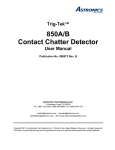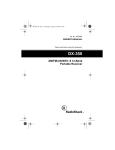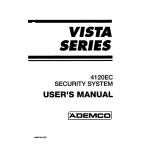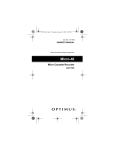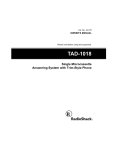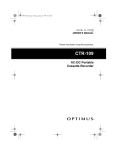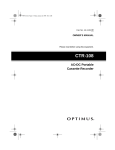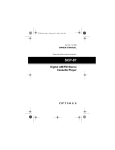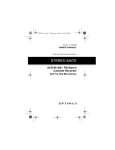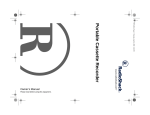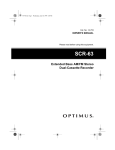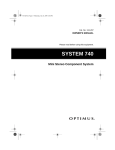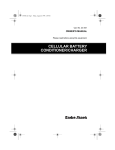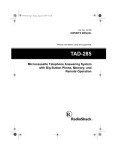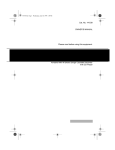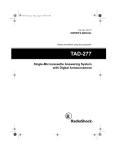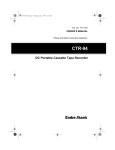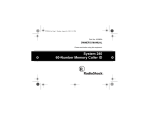Download Optimus CTR-107 Cassette Player User Manual
Transcript
14-1112.fm Page 1 Thursday, July 1, 1999 1:05 PM Cat. No. 14-1112 OWNER’S MANUAL Please read before using this equipment. CTR-107 Portable Cassette Tape Recorder 14-1112.fm Page 2 Thursday, July 1, 1999 1:05 PM FEATURES Your Optimus CTR-107 Portable Cassette Tape Recorder has a lightweight, portable design that makes it perfect for recording lectures, interviews, business meetings, and speeches. The recorder’s voice activation feature lets you set the recorder to automatically record only when it picks up sound. This saves room on your cassette tape, conserves battery power, and lets you record without manually stopping the recorder whenever a long pause or break occurs. The recorder also includes these features: Built-In Condenser Microphone — provides good quality recordings. Built-In Speaker — lets you listen to your recordings without connecting an earphone. Cue/Review — lets you listen to recordings at a high speed to help you find a particular section. © 1997 Tandy Corporation. All Rights Reserved. Optimus is a registered trademark used by Tandy Corporation. RadioShack is a trademark used by Tandy Corporation. 2 14-1112.fm Page 3 Thursday, July 1, 1999 1:05 PM Tape Counter — helps you quickly locate a specific section on the tape. Automatic Level Control (ALC) Circuit — automatically adjusts to the proper recording level. Auto Stop — automatically stops the recorder when the tape reaches the end during playback or recording. Pause Control — lets you edit as you record. Three Power Sources — let you power the recorder using four AA batteries, a standard AC outlet (with an optional AC adapter), or your vehicle’s cigarettelighter socket (with an optional DC adapter). Built-In Carrying Strap — lets you easily carry the cassette recorder anywhere you go. Supplied Earphone — lets you listen in privacy. Erase Plug — lets you erase a tape without recording any sound over it. MIC Jack — lets you connect an optional external microphone. 3 14-1112.fm Page 4 Thursday, July 1, 1999 1:05 PM CONTENTS Preparation ........................................................... 5 Connecting Power ........................................... 5 Using Internal Batteries ............................ 5 Using AC Power ....................................... 8 Using Vehicle Battery Power .................. 10 Using the Earphone ...................................... 12 Listening Safely ...................................... 12 Traffic Safety .......................................... 13 Operation ............................................................ 14 Loading a Cassette Tape .............................. 14 Playing a Cassette Tape ............................... 16 Using Fast-Forward/Rewind ................... 18 Using the Tape Counter ......................... 19 Recording ...................................................... 20 Using an External Microphone ............... 22 Tape Tips ....................................................... 24 Recommended Tapes ............................ 24 Erasing a Cassette Tape ........................ 24 Preventing Accidental Erasure ............... 25 Restoring Tape Tension and Sound Quality ........................................ 27 Maintenance ........................................................ 28 Cleaning the Tape-Handling Parts ................ 30 Specifications ..................................................... 33 4 14-1112.fm Page 5 Thursday, July 1, 1999 1:05 PM PREPARATION CONNECTING POWER You can power the CTR-107 from any of three power sources: • Internal batteries • Standard AC power (with an optional AC adapter) • Your vehicle’s cigarette-lighter socket (with an optional DC adapter) Note: Connecting an adapter disconnects internal batteries. Using Internal Batteries You can power the CTR-107 from four AA batteries (not supplied). For the best performance, we recommend alkaline batteries, such as RadioShack Cat. No. 23-557. You can also use rechargeable nickel-cadmium batteries (Cat. No. 23-125) with a battery charger (Cat. No. 23-133). 5 14-1112.fm Page 6 Thursday, July 1, 1999 1:05 PM Follow these steps to install batteries: 1. Press down on the battery compartment cover and slide it off in the direction of the arrows. 2. Install the batteries as indicated by the polarity symbols (+ and –) marked outside the compartment. Cautions: • Use only fresh batteries of the required size and type. • Do not mix old and new batteries, different types of batteries (standard, alkaline, or rechargeable), or rechargeable batteries of different capacities. • Always dispose of old batteries promptly and properly. 6 14-1112.fm Page 7 Thursday, July 1, 1999 1:05 PM • Never leave dead, old or weak batteries in the CTR-107. Batteries can leak chemicals and corrode or damage electronic circuits. 3. Replace the cover. Notes: • If you plan not to use the CTR-107 for a week or more, or you plan to use an AC or DC adapter, remove the batteries to protect the CTR-107 from possible battery leakage. • When the RECORD/BATT indicator becomes dim during operation or does not light when you turn on the recorder, replace the batteries. 7 14-1112.fm Page 8 Thursday, July 1, 1999 1:05 PM Important: Your recorder is capable of using rechargeable nickel-cadmium batteries. At the end of the batteries’ life, they must be recycled or disposed of properly. Contact your local, county, or state hazardous waste management authorities for information on recycling or disposal programs in your area. Some options that might be available are: municipal curbside collection, drop-off boxes at retailers such as your local RadioShack store, recycling collection centers, and mail-back programs. Using AC Power To power the CTR-107 from an AC outlet, you need an AC adapter (not supplied), such as Cat. No. 2731663 or 273-1664. Cautions: • The recommended AC adapter supplies 6 volts and delivers at least 300 millliamps. Its center tip is set to negative, and its plug correctly fits the DC 6V jack on the CTR-107. Using an adaper that does not meet these specifications could seriously damage the CTR-107 or the adapter. 8 14-1112.fm Page 9 Thursday, July 1, 1999 1:05 PM • Always plug the AC adapter into the CTR-107 before you plug it into the AC outlet, and unplug the AC adapter from the AC outlet before you unplug its barrel plug from the CTR-107. Follow these steps to connect the CTR-107 to AC power. 1. Set the adapter’s voltage switch to 6V. 2. Insert the adapter’s 5.5 mm outer diameter/2.1 mm inner diameter barrel plug into the adapter’s cord so it reads –TIP. 3. Insert the AC adapter’s barrel plug into the DC 6V jack on the CTR-107. 4. Plug the AC adapter into a standard AC outlet. 9 14-1112.fm Page 10 Thursday, July 1, 1999 1:05 PM Using Vehicle Battery Power You can power the CTR-107 from your vehicle’s cigarette-lighter socket using a DC adapter (not supplied), such as Cat. No. 273-1802. Cautions: • The recommended DC adapter supplies 6 volts and delivers at least 300 milliamps. Its center tip is set to negative, and its plug correctly fits the CTR-107’s DC 6V jack. Using an adapter that does not meet these specifications could damage the CTR-107 or the adapter. • Always plug the DC adapter into the CTR-107 before you plug it into the cigarette-lighter socket, and always unplug the adapter from the cigarette-lighter socket before you unplug it from the CTR-107. 10 14-1112.fm Page 11 Thursday, July 1, 1999 1:05 PM Follow these steps to connect the CTR-107 to vehicle battery power. 1. Set the DC adapter’s voltage switch to 6V. 2. Insert the adapter’s barrel plug into the CTR107’s DC 6V jack. 3. Plug the adapter’s larger plug into the vehicle’s cigarette-lighter socket. 11 14-1112.fm Page 12 Thursday, July 1, 1999 1:05 PM USING THE EARPHONE To listen in privacy, insert the supplied earphone’s 1/8inch plug into the EAR jack. Note: Connecting the earphone automatically disconnects the built-in speaker. Listening Safely To protect your hearing, follow these guidelines when you use the earphone. • Set the volume to the lowest setting before you begin listening. After you begin listening, adjust the volume to a comfortable level. • Do not listen at extremely high volume levels. Extended high volume listening can lead to permanent hearing loss. 12 14-1112.fm Page 13 Thursday, July 1, 1999 1:05 PM • Once you set the volume, do not increase it. Over time, your ears adapt to the volume level, so a volume level that does not cause discomfort might still damage your hearing. Traffic Safety Do not wear the earphone while operating a motor vehicle or riding a bicycle. This can create a traffic hazard and is illegal in some areas. Even though some earphones are designed to let you hear some outside sounds when listening at normal volume levels, they still present a traffic hazard. 13 14-1112.fm Page 14 Thursday, July 1, 1999 1:05 PM OPERATION LOADING A CASSETTE TAPE Note: Metal tapes are not recommended for use with this cassette player. 1. Take up any slack in the tape by turning one of the cassette’s hubs with a pencil. Do not touch the tape. Caution: If you do not remove the excess slack, the tape might become tangled in the record/ playback mechanism. 14 14-1112.fm Page 15 Thursday, July 1, 1999 1:05 PM 2. Press STOP/EJECT to open the cassette compartment door. 3. Load the cassette with its open edge out, the side you want to play facing up, and its full reel to the left. 4. Close the door. 15 14-1112.fm Page 16 Thursday, July 1, 1999 1:05 PM PLAYING A CASSETTE TAPE 1. Load the cassette tape. 2. Press PLAY. The cassette plays until it reaches the end of the side, then it automatically stops. Note: Press PAUSE to temporarily stop playback. Press PAUSE again to resume playback. 16 14-1112.fm Page 17 Thursday, July 1, 1999 1:05 PM 3. Adjust VOLUME as desired. 4. Press STOP/EJECT to completely stop playback before it automatically stops. Press STOP/EJECT again to open the cassette compartment and remove the cassette tape. 17 14-1112.fm Page 18 Thursday, July 1, 1999 1:05 PM Using Fast-Forward/Rewind While the tape is stopped, press REVIEW/REWIND or CUE/FAST-F to rapidly wind the tape backward or forward. Press STOP/EJECT, then PLAY again to resume playback. If you press and hold down REVIEW/REWIND or CUE/ FAST-F while the tape is playing, you can hear the tape as it moves at a faster speed. This makes it easy to locate a specific part of a recording (such as the space between tracks). When you release REVIEW/ REWIND or CUE/FAST-F, the tape plays at its normal speed. 18 14-1112.fm Page 19 Thursday, July 1, 1999 1:05 PM Using the Tape Counter You can use the tape counter to help you find specific locations on the tape. At the beginning of a tape, press the reset button to reset the tape counter to 000. Then note the counter’s reading at the beginnng of each selection. To return to a selection, fast-forward or rewind the tape until the counter shows the noted reading. 19 14-1112.fm Page 20 Thursday, July 1, 1999 1:05 PM RECORDING Notes: • Before you load a cassette tape for recording, be sure its erase-protection tabs are in place (see “Preventing Accidental Erasure” on Page 25). • The recorder’s Automatic Level Control (ALC) circuit automatically adjusts the recording level. VOLUME has no effect on recording. 1. Load a blank cassette tape, or one you want to record over, into the cassette compartment. 2. Set VOICE ACTIVATION to the desired sensitivity. HIGH — begins recording from soft, low sounds as well as loud sounds. LOW — requires a normal to loud sound to begin recording. 20 14-1112.fm Page 21 Thursday, July 1, 1999 1:05 PM OUT — immediately begins recording when you press RECORD (unless PAUSE is pressed down). 3. Press RECORD to begin recording. Both PLAY and RECORD lock down. As the recorder records, the RECORD/BATT indicator flashes. Notes: • If VOICE ACTIVATION is set to HIGH or LOW, recording begins when the recorder detects an audible signal. If the sound stops or becomes inaudible for about 5 seconds, the recorder automatically stops. The recorder automatically starts recording again when the recorder receives another audible signal. • If you press and hold down REVIEW/REWIND or CUE/FAST-F while recording, the RECORD button releases and the tape rewinds or fastforwards. You can hear the recorded sound so you can locate any desired segment on the tape. When you release REVIEW/REWIND or CUE/FAST-F, the recorder plays the cassette. To continue recording, press STOP/EJECT, then press RECORD. • To temporarily stop recording, press PAUSE. Press PAUSE again to resume recording. 21 14-1112.fm Page 22 Thursday, July 1, 1999 1:05 PM 4. Press STOP/EJECT to stop recording before it automatically stops at the end of the tape side. Using an External Microphone You can connect an external microphone (not supplied) with a 1/8-inch plug to the CTR-107. The proper microphone to use with this recorder is Cat. No. 333014. Its microphone plug correctly fits the CTR107’s MIC jack. Note: Connecting an external microphone automatically disconnects the built-in microphone. 1. Insert the microphone’s 1/8-inch plug into the CTR-107’s MIC jack. Then follow the steps in “Recording” on Page 20. 22 14-1112.fm Page 23 Thursday, July 1, 1999 1:05 PM Notes: • If the external microphone has a separate, smaller plug for remote operation, insert that plug into the REMOTE jack, then use the microphone’s switch to turn on and off the recorder. If VOICE ACTIVATION is not set to OUT, recording only starts when the switch is on and the recorder receives an audible signal. • You can monitor the recording with the supplied earphone. Otherwise, do not use the earphone during recording. The built-in microphone’s circuitry can cause feedback noise in the earphone. 2. Speak into the external microphone. 23 14-1112.fm Page 24 Thursday, July 1, 1999 1:05 PM TAPE TIPS Recommended Tapes Tape quality greatly affects the quality of the recording. We recommend extended-range or low noise Type 1 regular length (60- or 90-minute) normal-bias cassette tapes. We do not recommend long-play cassette tapes such as C-120s because they are thin and can easily tangle. Erasing a Cassette Tape To record over a cassette tape, simply record as usual. The cassette deck records over the previous recording. To erase the entire cassette tape, insert the supplied erasing plug into the MIC jack and press RECORD . 24 14-1112.fm Page 25 Thursday, July 1, 1999 1:05 PM If you need to erase an entire cassette, you might prefer using a bulk tape eraser, available at your local RadioShack store. Preventing Accidental Erasure Cassette tapes have two erase-protection tabs — one for each side. When a tab is in place, you can record on that side. To protect a recording from being accidentally recorded over or erased, use a screwdriver to remove one or both of the cassette tape’s erase-protection tabs. This prevents RECORD from being pressed. 25 14-1112.fm Page 26 Thursday, July 1, 1999 1:05 PM If you later decide to record on a tape side after you have removed its erase-protection tab, place a piece of strong plastic tape over the side’s erase-protection hole. Be sure you cover only the hole originally covered by the erase-protection tab. Caution: Removing the erase-protection tabs does not prevent a bulk tape eraser from erasing a cassette tape. 26 14-1112.fm Page 27 Thursday, July 1, 1999 1:05 PM Restoring Tape Tension and Sound Quality After you play a cassette tape several times, the tape might become tightly wound on the reels. This can cause playback sound quality to deteriorate. To restore the sound quality, fast-forward the tape from the beginning to the end of one side, then completely rewind it. Then loosen the tape reels by gently tapping each side of the cassette’s outer shell on a flat surface. Caution: Be careful not to damage the cassette when tapping it. Do not touch the exposed tape or allow any sharp objects near the cassette. 27 14-1112.fm Page 28 Thursday, July 1, 1999 1:05 PM MAINTENANCE Your Optimus CTR-107 Portable Cassette Tape Recorder is an example of superior design and craftsmanship. The following suggestions will help you care for your CTR-107 so you can enjoy it for years. • Keep the CTR-107 dry. If it gets wet, wipe it dry immediately. Liquids can contain minerals that corrode electronic circuits. • Use and store the CTR-107 only in normal temperature environments. Temperature extremes can shorten the life of electronic devices, damage batteries, and distort or melt plastic parts. • Handle the CTR-107 gently and carefully. Dropping it can damage circuit boards and cases and can cause the CTR-107 to work improperly. • Keep the CTR-107 away from dust and dirt, which can cause premature wear of parts. • Use only fresh batteries of the recommended size and type. Old batteries can leak chemicals that can damage your CTR-107’s electronic circuits. • Wipe the CTR-107 with a damp cloth occasionally to keep it looking new. Do not use harsh chemicals, cleaning solvents, or strong detergents to clean your CTR-107. 28 14-1112.fm Page 29 Thursday, July 1, 1999 1:05 PM Modifying or tampering with the CTR-107’s internal components can cause a malfunction and might invalidate your CTR-107’s warranty. If your CTR-107 is not performing as it should, take it to your local RadioShack store for assistance. 29 14-1112.fm Page 30 Thursday, July 1, 1999 1:05 PM CLEANING THE TAPE-HANDLING PARTS Dirt, dust, or particles of the tape’s coating can accumulate on the tape heads and other parts that the tape touches. This can greatly reduce the cassette player’s performance. To help keep the cassette player working at its best, clean the cassette player’s tape-handling parts after every 20 hours of use. 1. Remove the batteries and disconnect any other power source. 2. Open the cassette compartment cover. 30 14-1112.fm Page 31 Thursday, July 1, 1999 1:05 PM 3. Use a pencil eraser to press down on the erase protection tab sensor in the cassette compartment. Then press RECORD to expose the tapehandling parts. 31 14-1112.fm Page 32 Thursday, July 1, 1999 1:05 PM 4. Use a swab dipped in alcohol to gently clean the capstan, pinch roller, tape guides, and tape and erase heads. 5. When you finish cleaning, press STOP/EJECT and close the compartment cover. Then reconnect power. You can also use a cassette deck cleaning kit, available from your local RadioShack store. 32 14-1112.fm Page 33 Thursday, July 1, 1999 1:05 PM SPECIFICATIONS CASSETTE PLAYER Tape System ..................................2-Track Monaural Tape Speed ...................................................17/8 in/s Wow and Flutter (WRMS) ...............................0.35% Signal-to-Noise Ratio ...................................... 35 dB Recording System ........................................ AC Bias Erase System .................................................Magnet GENERAL Power Requirements ...............................6 Volts DC, 4 AA Batteries (Cat. No. 23-557), AC Adapter (Cat. No. 273-1662), or DC Adapter (Cat. No. 273-1802) Dimensions (HWD)................ 73/8 x 43/4 x 13/8 Inches (188 x 121 x 36 mm) Weight ......................................................... 14.11 oz (400 gm) Included Accessories .............Earphone, Erase Plug Specifications are typical; individual units might vary. Specifications are subject to change and improvement without notice. 33 14-1112.fm Page 34 Thursday, July 1, 1999 1:05 PM NOTES 34 14-1112.fm Page 35 Thursday, July 1, 1999 1:05 PM 35 14-1112.fm Page 36 Thursday, July 1, 1999 1:05 PM Limited Ninety-Day Warranty This product is warranted by RadioShack against manufacturing defects in material and workmanship under normal use for ninety (90) days from the date of purchase from RadioShack company-owned stores and authorized RadioShack franchisees and dealers. In the event of a product defect during the warranty period, take the product and the RadioShack sales receipt as proof of purchase date to any RadioShack store. RadioShack will, at its option, unless otherwise provided by law: (a) correct the defect by product repair without charge for parts and labor; (b) replace the product with one of the same or similar design; or (c) refund the purchase price. All replaced parts and products, and products on which a refund is made, become the property of RadioShack. New or reconditioned parts and products may be used in the performance of warranty service. Repaired or replaced parts and products are warranted for the remainder of the original warranty period. You will be charged for repair or replacement of the product made after the expiration of the warranty period. This warranty does not cover: (a) damage or failure caused by or attributable to acts of God, abuse, accident, misuse, improper or abnormal usage, failure to follow instructions, improper installation or maintenance, alteration, lightning or other incidence of excess voltage or current; (b) any repairs other than those provided by a RadioShack Authorized Service Facility; (c) consumables such as fuses or batteries; (d) cosmetic damage; (e) transportation, shipping or insurance costs; or (f) costs of product removal, installation, set-up service adjustment or reinstallation. EXCEPT AS PROVIDED HEREIN, RadioShack MAKES NO EXPRESS WARRANTIES AND ANY IMPLIED WARRANTIES, INCLUDING THOSE OF MERCHANTABILITY AND FITNESS FOR A PARTICULAR PURPOSE, ARE LIMITED IN DURATION TO THE DURATION OF THE WRITTEN LIMITED WARRANTIES CONTAINED HEREIN. EXCEPT AS PROVIDED HEREIN, RadioShack SHALL HAVE NO LIABILITY OR RESPONSIBILITY TO CUSTOMER OR ANY OTHER PERSON OR ENTITY WITH RESPECT TO ANY LIABILITY, LOSS OR DAMAGE CAUSED DIRECTLY OR INDIRECTLY BY USE OR PERFORMANCE OF THE PRODUCT OR ARISING OUT OF ANY BREACH OF THIS WARRANTY, INCLUDING, BUT NOT LIMITED TO, ANY DAMAGES RESULTING FROM INCONVENIENCE, LOSS OF TIME, DATA, PROPERTY, REVENUE, OR PROFIT OR ANY INDIRECT, SPECIAL, INCIDENTAL, OR CONSEQUENTIAL DAMAGES, EVEN IF RadioShack HAS BEEN ADVISED OF THE POSSIBILITY OF SUCH DAMAGES. Some states do not allow the limitations on how long an implied warranty lasts or the exclusion of incidental or consequential damages, so the above limitations or exclusions may not apply to you. This warranty gives you specific legal rights, and you may also have other rights which vary from state to state. RadioShack Customer Relations, Dept. W, 100 Throckmorton St., Suite 600, Fort Worth, TX 76102 We Service What We Sell 1/97 RadioShack A Division of Tandy Corporation Fort Worth, Texas 76102 4A7 Printed in Hong Kong





































